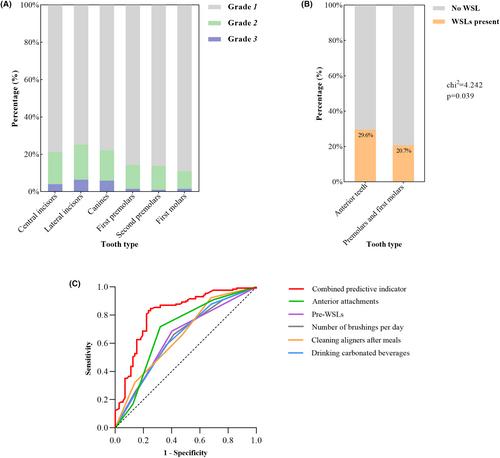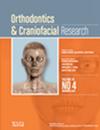Incidence, severity, and risk factors for white spot lesions in adolescent patients treated with clear aligners
Abstract
Objectives
This study was aimed to clarify the incidence, severity, and clinical risk factors for white spot lesions (WSLs) in adolescent patients treated with clear aligners.
Methods
Pre-treatment and post-treatment intraoral photographs of 203 adolescent patients undergoing clear aligner therapy were retrospectively evaluated to assess the occurrence and severity of WSLs. Information on patients' general oral condition and orthodontic treatment was collected from clinical medical documents, retrospective questionnaires, and ClinCheck® software. Independent risk factors and model performance were determined by multivariate logistic regression and receiver operating characteristic curve analysis.
Results
Thirty-five percent of adolescent patients developed WSLs during clear aligner treatment. Logistic regression analysis revealed that the presence of WSLs before treatment (OR 2.484, 95% CI 1.245-4.957), frequency of drinking carbonated beverages (OR 1.508, 95% CI 1.045-2.177), and number of anterior attachments (OR 2.192, 95% CI 1.502-3.198) were risk factors for the occurrence of WSLs in adolescent patients treated with clear aligners (P < .05), whereas the number of times they brushed each day (OR 0.656, 95% CI 0.454-0.947) and frequency of aligner cleaning after eating while wearing them (OR 0.611, 95% CI 0.433-0.861) were protective factors against WSLs (P < .05).
Conclusions
The incidence of WSLs was high in adolescent patients treated with clear aligners. Few brushings each day, pre-treatment WSLs, a high frequency of drinking carbonated beverages, a low frequency of aligner cleaning after eating while wearing them, and a high number of anterior attachments are strongly associated with the development of WSLs in adolescent patients treated with clear aligners.


 求助内容:
求助内容: 应助结果提醒方式:
应助结果提醒方式:


